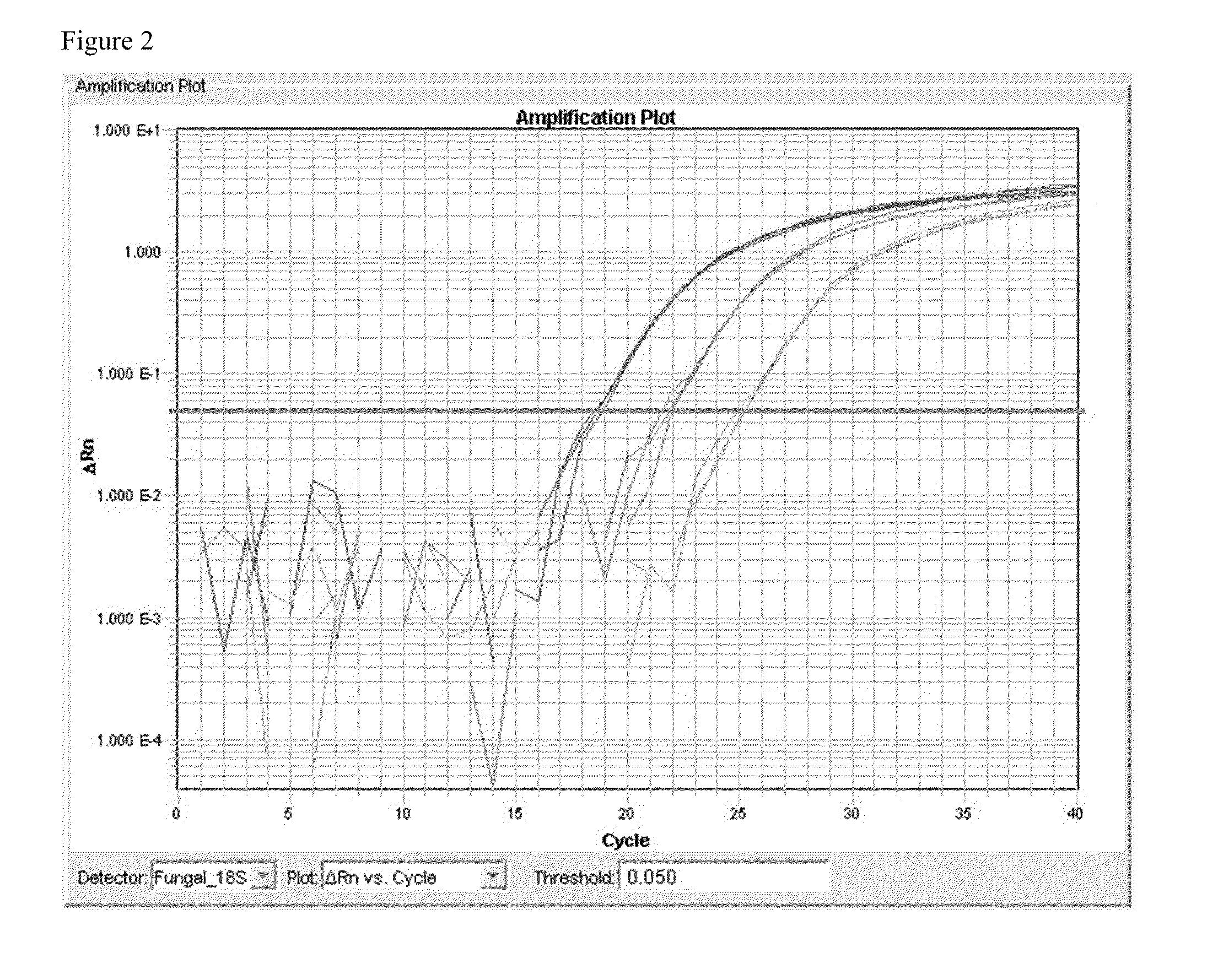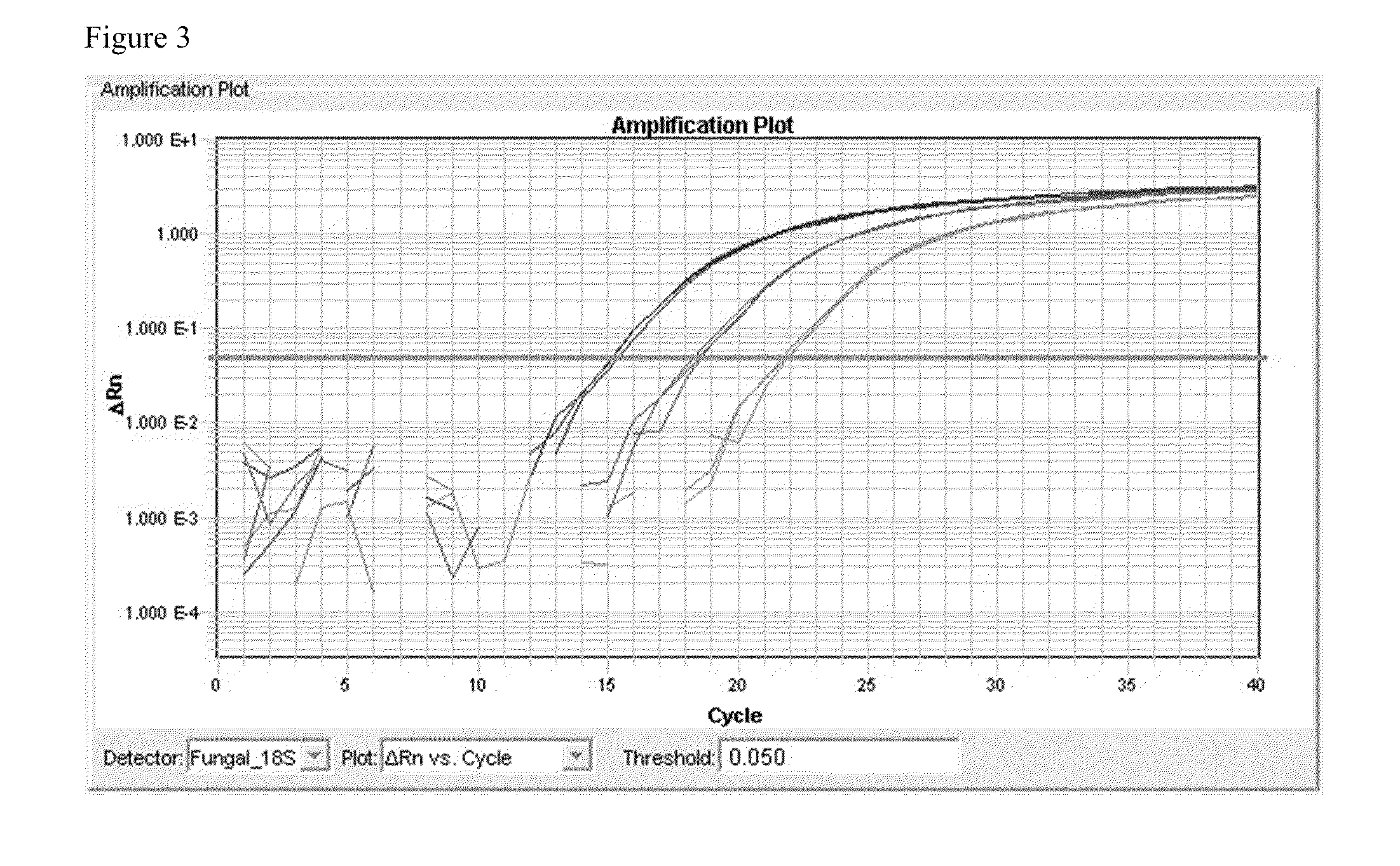Methods and kits used in the detection of fungus
- Summary
- Abstract
- Description
- Claims
- Application Information
AI Technical Summary
Benefits of technology
Problems solved by technology
Method used
Image
Examples
example 1
Detection and Quantitation of Fungi by RT-PCR Using Pan-Fungal Primers and Probes
[0049]The primers of this invention were designed to enable broad-coverage assays for the detection of fungal organisms. Sequences were exported from the Silva ribosomal RNA database (http: / / www.arb-silva.de) and used to generate massive multiple sequence alignment files for the 18S rRNA gene, the 5.8S rRNA gene, and the 28S rRNA gene from all major fungi phyla. The sequence filter setting in the primer design software was optimized in order to capture the maximal number of sequences. A base distribution file was generated from the multiple sequence alignment files by summarizing the number of sequences with each base (A, T, C, G) at each locus. Regions with at least 6 bases at >99% conservation at the 3′ end of the primer (5′-3′ direction) were then identified using a combination of Tm assessment and degeneracy minimization (n=3 or less).
[0050]After the primer / probe design, specificity of the primer se...
example 2
Ability of 18S rRNA Quantitative PCR Assay to Detect Fungal Species Relative to Other Pan-Fungal Assays
[0063]In silico analysis showed that a qPCR assay using the primer / probe set represented by SEQ ID NO. 1, SEQ ID NO. 2, and SEQ ID NO. 3 has a coverage of 90.80% of all 2082 available fungal 18S rRNA gene sequences.
[0064]In silico validation of pan-fungal primers comprises two parts: a primer analysis portion and an assay analysis portion. The primer analysis code parses the primer sequence (accommodating for degeneracies). The primer location in the alignment is determined and the alignment is scanned for sequences that have poor data in that region. Once poor quality sequences are removed, the primer and its reverse complement are compared for perfect matches to each sequence in the alignment. Matched sequences and missed sequences are recorded in separate output files and the data is summarized on-screen prior to termination of the program.
[0065]The assay analysis portion scans ...
example 3
Primers Used to Generate a Cloned Standard for use in Quantitative Validation
[0069]A set of primers was generated that is capable of producing quantitative cloned standards. Clone libraries may also be generated from pan-fungal PCR primers capable of amplifying the entire 18S rRNA gene.
SEQ IDNameSequenceSEQ ID NO. 418S_TGEN_library_F15′-GGAGARRGAGCCTGAGA-3′SEQ ID NO. 518S_TGEN_library_R15′-CTAGGNATTCCTCGTTSAAG-3′
[0070]The SEQ ID NO. 4 and SEQ ID NO. 5 primer set was used to generate a cloned plasmid to be used in quantitative and sensitivity / specificity preliminary validation. Using the cloned standard, the assay has shown a dynamic range of 109 copies / ul to 102 copies / ul without amplifying human genomic DNA in this dynamic range.
PUM
| Property | Measurement | Unit |
|---|---|---|
| Fraction | aaaaa | aaaaa |
| Fraction | aaaaa | aaaaa |
| Fluorescence | aaaaa | aaaaa |
Abstract
Description
Claims
Application Information
 Login to View More
Login to View More - R&D
- Intellectual Property
- Life Sciences
- Materials
- Tech Scout
- Unparalleled Data Quality
- Higher Quality Content
- 60% Fewer Hallucinations
Browse by: Latest US Patents, China's latest patents, Technical Efficacy Thesaurus, Application Domain, Technology Topic, Popular Technical Reports.
© 2025 PatSnap. All rights reserved.Legal|Privacy policy|Modern Slavery Act Transparency Statement|Sitemap|About US| Contact US: help@patsnap.com



